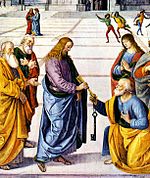- Pope Damasus I
-
Damasus I 
Papacy began 366 Papacy ended 384 Predecessor Liberius Successor Siricius Personal details Birth name Damasus Born ca. 305
Idanha-a-Nova, Lusitania, Hispania (now Portugal)Died December 11, 384
Rome, Western Roman EmpireSainthood Feast day December 11 Other Popes named Damasus Papal styles of
Pope Damasus I
Reference style His Holiness Spoken style Your Holiness Religious style Holy Father Posthumous style Saint Pope Saint Damasus I (
 /ˈdæməsəs/ dam-əs-əs) was the bishop of Rome from 366 to 384.
/ˈdæməsəs/ dam-əs-əs) was the bishop of Rome from 366 to 384.He was born around 305,[1] probably near the city of Idanha-a-Velha (in Lusitania, Hispania), in what is present-day Portugal, then part of the Western Roman Empire. His life coincided with the rise of Constantine I and the reunion and redivision of the Western and Eastern Roman Empires, associated with the widespread legitimization of Christianity and the later adoption of Christianity as the official religion of the Roman state.
Damasus is known to have been raised in the service of the Basilica of San Lorenzo fuori le Mura in Rome, and following the death of Pope Liberius, he succeeded to the Papacy amidst factional violence. A group of Damasus' supporters, previously loyal to his opponent Felix attacked and killed rivals loyal to Liberius' deacon Ursinus, in a riot that required the intervention of Emperor Valentinian I to quell.
Damasus faced accusations of murder and adultery (despite having not been married[2]) in his early years as pope. The neutrality of these claims have come into question with some suggesting that the accusations were motivated by the schismatic conflict with the supporters of Arianism. His personal problems were contrasted with his religious accomplishments, which included restoring Saint Lawrence outside the Walls, appointing Jerome as his personal secretary and encouraging his Vulgate translation of the Bible, and presiding over the Council of Rome in 382, which set down the canon of Scripture. He also did much to encourage the veneration of the martyrs.[3]
Contents
Early life
Damasus' parents were Antonius, a priest at the Church of St. Lawrence (San Lorenzo) in Rome, and Laurentia. During Damasus' early years, Constantine I rose to rule first the Western Roman Empire, presiding over the Edict of Milan (313) and winning religious freedom for Christians in all parts of the Roman Empire. A crisis precipitated by the rejection of religious freedom by Licinius, Emperor of the Eastern Roman Empire, in favor of paganism resulted in a civil war (324) that placed Constantine firmly in control of a reunited Empire, and led to the establishment of Christian religious supremacy in Constantinople, called Nova Roma as well as Rome, gradually leading to a see which sought to rival the authority of the Roman See. Damasus would have been in his twenties at the time.
Rise in the Church
When Pope Liberius was banished by Emperor Constantius II to Berea, in 354, Damasus was archdeacon of the Roman church and followed Liberius into exile, though he immediately returned to Rome. During the period before Liberius' return, Damasus had a great share in the government of the church.[4]
The succession crisis
In the early Church, new Bishops of Rome were elected or chosen by the clergy and the people of the diocese in the presence of the other bishops in the province, which was the manner customarily used in other dioceses. While this simple method worked well in a small community of Christians unified by persecution, as the congregation grew in size, the acclamation of a new bishop was fraught with division, and rival claimants and a certain class hostility between patrician and plebeian candidates unsettled some episcopal elections. At the same time, 4th century emperors expected each new pope-elect to be presented to them for approval, which sometimes led to state domination of the Church's internal affairs.
On the death of Liberius, September 24, 366, one faction supported Ursinus (or Ursicinus) who had served as deacon to Liberius, while the other faction, previously loyal to the Antipope Felix II, supported Damasus. The upper-class partisans of Felix supported the election of Damasus, but the opposing supporters of Liberius, the deacons and laity, supported Ursinus; the two were elected simultaneously (Damasus' election was held in San Lorenzo in Lucina), in an atmosphere of rioting. Supporters already clashed at the beginning of October. Such was the violence and bloodshed that the two prefects of the city were called in to restore order, and after a first setback, when they were driven to the suburbs and a massacre of 137 was perpetrated in the basilica of Sicininus (the modern Basilica di Santa Maria Maggiore), the prefects banished Ursinus to Gaul.[5] There was further violence when he returned, which continued after Ursinus was exiled again.
Church historians, such as St. Jerome and Rufinus, championed Damasus. At a synod in 378 Ursinus was condemned and Damasus exonerated and declared the true pope. The former antipope continued to intrigue against Damasus for the next few years, and unsuccessfully attempted to revive his claim on Damasus's death. Ursinus was among the Arian party in Milan, according to Ambrose.[6]
This dissension climaxed with a riot which led to a three-day massacre and to the rare intervention of Emperor Valentinian I to uphold public order. Damasus prevailed, but only with the support of the city prefect. Once he was securely consecrated bishop of Rome, his men attacked Ursinus and his remaining supporters who were seeking refuge in the Liberian basilica, resulting in a massacre of one hundred and thirty seven supporters of Ursinus. Damasus was also accused of murder before a later prefect, but his rich friends secured the personal intervention of the emperor to rescue him from this humiliation. The reputations of both Damasus and the Roman church in general suffered greatly due to these two unseemly incidents.
Edward Gibbon writes, "The enemies of Damasus styled him Auriscalpius Matronarum, the ladies' ear-scratcher."[7]
Association with Jerome, defense of the Church against schism
Damasus I was active in defending the Catholic Church against the threat of schisms. In two Roman synods (368 and 369) he condemned Apollinarianism and Macedonianism, and sent legates to the First Council of Constantinople that was convoked in 381 to address these heresies.
Pope Damasus appointed Jerome as his confidential secretary. Writing in 409 Jerome remarks, "A great many years ago when I was helping Damasus, bishop of Rome with his ecclesiastical correspondence, and writing his answers to the questions referred to him by the councils of the east and west..."[8] If "east and west" do not betray the passage as an interpolation, Jerome spent three years (382–385) in Rome in close intercourse with Pope Damasus and the leading Christians. Invited there originally to a synod of 382 convened to end the schism of Antioch, he made himself indispensable to the pope, and took a prominent place in his councils.
In order to put an end to the marked divergences in the western texts of that period, Damasus encouraged the highly respected scholar to revise the available Old Latin versions of the Bible into a more accurate Latin on the basis of the Greek New Testament and the Septuagint, resulting in the Vulgate. Jerome devotes a very brief notice to Damasus in his De Viris Illustribus, written after Damasus' death: "he had a fine talent for making verses and published many brief works in heroic metre. He died in the reign of the emperor Theodosius at the age of almost eighty".[9]
St. Damasus sat in the Chair of St. Peter eighteen years and two months. His feast day is December 11.
Emperor Gratian
The reign of Gratian, during Damasus' papacy, forms an important epoch in ecclesiastical history, since during that period (359–383), Catholic Christianity, for the first time became dominant throughout the empire. Under the influence of Ambrose, Gratian prohibited pagan worship at Rome; refused to wear the insignia of the pontifex maximus as unbefitting a Christian; removed the Altar of Victory from the Senate at Rome, despite protests of the pagan members of the Senate, and confiscated its revenues; forbade legacies of real property to the Vestals; and abolished other privileges belonging to them and to the pontiffs.
Relations with other churches
The Eastern Church, in the person of St. Basil of Caesarea, sought earnestly the aid and encouragement of Damasus against an apparently triumphant Arianism; Damasus, however, harbored some degree of suspicion against the great Cappadocian Doctor of the Church. In the matter of the Meletian Schism at Antioch, Damasus—together with Pope St. Athanasius of Alexandria and his successor, Peter II of Alexandria—sympathized with the party of Paulinus as more sincerely representative of Nicene orthodoxy; on the death of Meletius he sought to secure the succession for Paulinus and to exclude Flavian.[10] He supported the appeal of the Christian senators to Emperor Gratian for the removal of the altar of Victory from the Senate House,[11] and lived to welcome the famous edict of Theodosius I, "De fide Catholica" (February 27, 380),[12] which proclaimed as the religion of the Roman State that doctrine which Saint Peter had preached to the Romans and of which Damasus was head.[13]
During his papacy, Peter II was obliged for a while to seek refuge in Rome from the persecuting Arians. He was received by Damasus, who sympathised with him and gave him support against the Arians.[13] This reconciled the relations between the Church of Rome and the Church of Antioch, which both supported the Church of Alexandria.
Devotion to Saint Laurence
Damasus rebuilt or repaired a church named for Saint Laurence, known as San Lorenzo fuori le Mura ("St Lawrence outside the walls"), which by the 7th century was a station on the itineraries of the graves of the Roman martyrs.
Damasus' devotion for the Roman martyr is attested also by the tradition, according to which the pope built a church devoted to Laurence in his own house, San Lorenzo in Damaso.
Letters of Jerome to Damasus
Further information: Letter of Jerome to Pope DamasusThe alleged letters from Jerome to Damasus have sometimes been adduced as examples of the primacy of the seat of Peter:
- …Yet, though your greatness terrifies me, your kindness attracts me. From the priest I demand the safe-keeping of the victim, from the shepherd the protection due to the sheep. Away with all that is overweening; let the state of Roman majesty withdraw. My words are spoken to the successor of the fisherman, to the disciple of the cross. As I follow no leader save Christ, so I communicate with none but your blessedness, that is with the chair of Peter. For this, I know, is the rock on which the church is built! This is the house where alone the paschal lamb can be rightly eaten. This is the ark of Noah, and he who is not found in it shall perish when the flood prevails. But since by reason of my sins I have betaken myself to this desert which lies between Syria and the uncivilized waste, I cannot, owing to the great distance between us, always ask of your sanctity the holy thing of the Lord. Consequently I here follow the Egyptian confessors who share your faith, and anchor my frail craft under the shadow of their great argosies. I know nothing of Vitalis; I reject Meletius; I have nothing to do with Paulinus. He that gathers not with you scatters; he that is not of Christ is of Antichrist.[14]
Notes
- ^ The Liturgy of the Hours, Vol. I, December 11.
- ^ M. Walsh, Butler's Lives of the Saints (HarperCollins Publishers: New York, 1991), 413.
- ^ M. Walsh, Butler's Lives, 414.
- ^ ST DAMASUS, POPE, CONFESSOR (A.D. 305–384) from Eternal Word Television Network
- ^ Ammianus Marcellinus, 27.3.12; 27.9.9. Translated by J.C. Rolfe, Ammianus Marcellinus (Cambridge: Loeb Classical Library, 1939), pp. 19, 61ff
- ^ Ambrose, Epistles iv
- ^ Gibbon, The Decline and Fall of the Roman Empire chapter 25, n. 83
- ^ Epistle cxx.10
- ^ De Viris Illustribus, ch. 103
- ^ Socrates, Historia Ecclesiastica 5.15
- ^ Ambrose, Epistles xvii, n. 10
- ^ Codex Theodosianus XVI, 1, 2
- ^ a b
 "Pope St. Damasus I". Catholic Encyclopedia. New York: Robert Appleton Company. 1913.
"Pope St. Damasus I". Catholic Encyclopedia. New York: Robert Appleton Company. 1913. - ^ Letter of Jerome to Pope Damasus, 376, 2
References
- Chadwick, Henry. The Pelican History of the Church – 1: The Early Church.
- Walker, Williston. A History of the Christian Church.
External links
 Media related to Damasus I at Wikimedia Commons
Media related to Damasus I at Wikimedia Commons Chisholm, Hugh, ed (1911). "Damasus". Encyclopædia Britannica (11th ed.). Cambridge University Press.
Chisholm, Hugh, ed (1911). "Damasus". Encyclopædia Britannica (11th ed.). Cambridge University Press.- Opera Omnia by Migne Patrologia (Latin)
Catholic Church titles Preceded by
LiberiusBishop of Rome
Pope
366–384Succeeded by
SiriciusCatholic Church Organizations, Papacy, Teachings and Liturgical TraditionsHistory Jesus · Twelve Apostles · Early Christianity · History of the Papacy · Ecumenical Councils · Missions · Great Schism of East · Crusades · Great Schism of West · Protestant Reformation · Counter-Reformation · Catholic Church by country
Hierarchy Pope · Cardinals · Patriarchs · Major Archbishops · Primates · Metropolitans · Archbishops · Diocesan BishopsTheology Sacraments Mariology Doctors of
the ChurchAlbertus Magnus · Ambrose · Anselm of Canterbury · Anthony of Padua · Thomas Aquinas · Athanasius of Alexandria · Augustine of Hippo · Basil of Caesarea · Bede · Robert Bellarmine · Bernard of Clairvaux · Bonaventure · Petrus Canisius · Catherine of Siena · Peter Chrysologus · John Chrysostom · Cyril of Alexandria · Cyril of Jerusalem · Peter Damian · Ephrem the Syrian · Francis de Sales · Gregory of Nazianzus · Gregory the Great · Hilary of Poitiers · Isidore of Seville · Jerome · John of Damascus · John of the Cross · Lawrence of Brindisi · Leo the Great · Alphonsus Maria de Liguori · Teresa of Ávila · Thérèse of LisieuxPope Benedict XVI Preceding Popes Orders and
SocietiesVatican II Particular Churches
sorted by
Liturgical TraditionsAlexandrian · Coptic · Ethiopic · Antiochian · Maronite · Syriac · Syro-Malankara · Armenian · Armenian · Byzantine · Albanian · Belarusian · Bulgarian · Croatian · Greek · Hungarian · Italo-Albanian · Macedonian · Melkite · Romanian · Russian · Ruthenian · Slovak · Ukrainian · East Syrian · Chaldean · Syro-Malabar · Latin · Roman · Anglican Use · Sarum · Ambrosian · MozarabicHistory of the Catholic Church General History of the Catholic Church · History of the Papacy · History of the Roman Curia · Catholic Ecumenical Councils · Timeline of the Catholic Church · History of Christianity · Role of the Catholic Church in Western civilization · Art in Roman Catholicism · Catholic religious order · Christian monasticism · Papal States
Church beginnings Constantine the Great to
Pope Gregory IConstantine the Great and Christianity · Arianism · Basilica of St. John Lateran · First Council of Nicaea · Pope Sylvester I · First Council of Constantinople · Biblical canon · Jerome · Vulgate · First Council of Ephesus · Council of Chalcedon · Benedict of Nursia · Second Council of Constantinople · Pope Gregory I · Gregorian chant
Early Middle Ages Third Council of Constantinople · Saint Boniface · Byzantine Iconoclasm · Second Council of Nicaea · Charlemagne · Pope Leo III · Fourth Council of Constantinople · East–West Schism
High Middle Ages Pope Urban II · Investiture Controversy · Crusades · First Council of the Lateran · Second Council of the Lateran · Third Council of the Lateran · Pope Innocent III · Latin Empire · Francis of Assisi · Fourth Council of the Lateran · Inquisition · First Council of Lyon · Second Council of Lyon · Bernard of Clairvaux · Thomas Aquinas
Late Middle Ages Protestant Reformation/
Counter-ReformationBaroque Period to the
French Revolution19th century Pope Pius VII · Pope Pius IX · Dogma of the Immaculate Conception of the Virgin Mary · Our Lady of La Salette · Our Lady of Lourdes · First Vatican Council · Papal infallibility · Pope Leo XIII · Mary of the Divine Heart · Prayer of Consecration to the Sacred Heart · Rerum Novarum
20th century Pope Pius X · Our Lady of Fátima · Persecutions of the Catholic Church and Pius XII · Pope Pius XII · Pope Pius XII Consecration to the Immaculate Heart of Mary · Dogma of the Assumption of the Virgin Mary · Pope John XXIII · Second Vatican Council · Pope Paul VI · Pope John Paul I · Pope John Paul II
21st century By country or region Brazil · Cuba · France · Germany · Hispano-America · Ireland · Japan · Mexico · Spain · United States · Venezuela
Categories:- 305 births
- 383 deaths
- Popes
- Portuguese popes
- Portuguese Roman Catholics
- 4th-century archbishops
- 4th-century Christian saints
- Ancient Christian controversies
- Church Fathers
- 4th-century Romans
- Romans from Hispania
Wikimedia Foundation. 2010.



